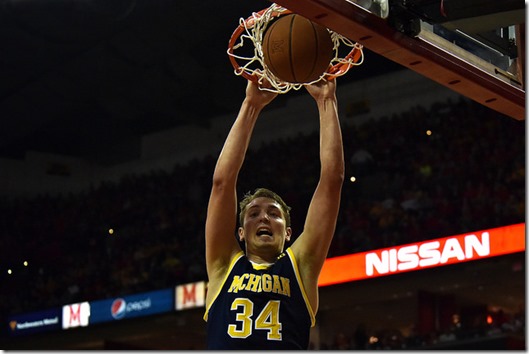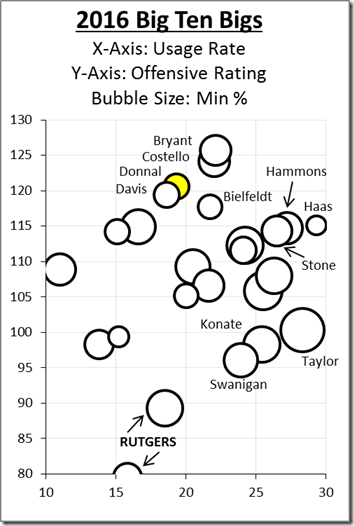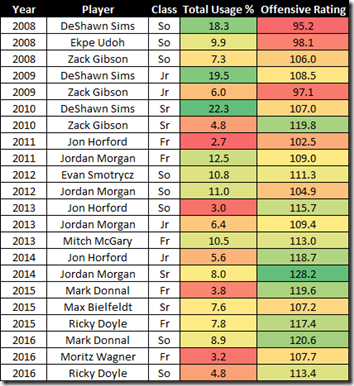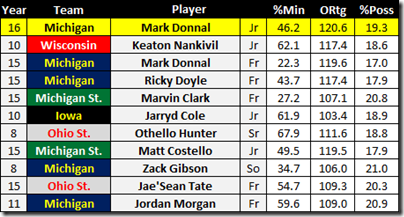Sherman
Previously: Zak Irvin, Muhammad-Ali Abdur-Rahkman, Duncan Robinson
During Michigan’s rocky non-conference season, the weak link on the squad was fairly obvious: the big men, most of whom were still young and / or inexperienced, really struggled. The implications were far-ranging – not only was the Wolverine defense particularly porous inside, but the pick-and-roll game on offense was starkly stagnant. Between Mark Donnal, Ricky Doyle, Moritz Wagner, and DJ Wilson, Michigan couldn’t cobble together more than a few consecutive solid shifts on the floor, let alone a strong 40 minutes of interior play. Needless to say, that – coupled with Michigan’s other early-season issues – led to blowout losses at the hands of some good teams. Watching Xavier’s front line feast in the Crisler Center early on was a sobering sign of how far the big men (and the team as a whole) had to come.
Then, in the first game of the Big Ten season, Mark Donnal discovered that he could dominate Illinois – a team with no inside presence whatsoever – to the tune of 26 points, 9 rebounds, 3 blocks and 2 steals. Caris LeVert was insistent on creating easy looks inside for Donnal and it worked; because fate is cruel, Caris went down with a foot injury late in that same game and couldn’t replicate that pick-and-roll chemistry again – which looked as good as it had in years for Michigan basketball. Still, even without LeVert, Donnal became much better at making himself available on the pick-and-roll and he became much more effective at converting the wide open looks that Michigan’s offense creates for its posts.
That wound up being his best game of the season – though a game at Maryland in which he scored 25 and had 5 blocks may have been close – but he still posted legitimately good numbers in the 18 games of Big Ten play:
- 3rd-best in the conference in Effective FG % and True Shooting %,
- 4th-best in 2-Point % (62.5)
- 8th-best in Offensive Rating (121.5)
- 8th-best in Offensive Rebounding Rate (11.7)
- 13th-best in Block Rate (4.9)
- 13th-best in Free Throw Rate (38.6)
- Maybe most importantly, 63.3% of available minutes
Donnal was a quintessentially efficient Michigan big man once his feel around the rim improved, even though he wasn’t a particularly physical finisher. In fact, despite his good block rate, he wasn’t a rim protector as Michigan allowed a horrendous percentage on opponent shots around the rim. That lack of physicality led to some criticism, and indeed, Michigan didn’t have much strength in the post, from Donnal or from anyone else (it’s worth noting that Donnal’s low defensive rebounding rate is not too much of a concern with Michigan’s team-wide success in clearing the defensive glass).
All in all, Donnal was an effective post in Michigan’s offense and was noticeably better than the other options on the depth chart (although MGoFavorite Moritz Wagner outplayed him in the NCAA Tournament), and his ability to stay on the court was key. He has one year of eligibility and a potential grad year (here or elsewhere), and his midseason awakening was huge in Michigan’s effort to get into the NCAA Tournament.
[More after the JUMP]
Data is from the entire season
From a statistical standpoint, Donnal was really quite good. While a huge number of his buckets were assisted, he was still able to work successfully off of pick-and-roll action to get those looks. If a guy like Duncan Robinson is standing in the strong-side corner in those plays, Donnal will be wide open if the ball-handler in the action can create any space to draw the big man’s attention, because teams are afraid to help off Michigan’s shooters.
As you can see, Donnal was one of the most efficient big men in the Big Ten this past season – the only two higher were Thomas Bryant (a potential future lottery pick) and Matt Costello (a very good senior). While other big men in the league had to soak up a large number of possessions – Purdue and Maryland’s giants, namely – Michigan’s offense is usually guard-oriented, so it’s not like Donnal can increase his number of possessions too steeply to cut into his solid efficiency. He’s a player who’s found his role on that end: set screens, pop for occasional threes, but most often roll to the rim and look to convert easy looks among the basket. Fortunately, it also seems like Donnal was also trying to incorporate back-tap offensive rebound opportunities late in the season to increase his already quality work in that regard.
All in all, I think Donnal was a roughly league-average starting center, maybe a little worse (and it’s worth considering that backups like Isaac Haas and Deyonta Davis were better). That was leaps and bounds better than what the Wolverines were getting in non-conference play, and even though the backup big situation never improved, Donnal was able to quickly move from a non-factor in the rotation to an adequate starting center.
* * *
Firstly, let’s take a minute to remember DeShawn Sims who is and will always be underrated and out of position in the early Beilein memories. It seems unlikely that we’ll see a high-usage big like Peedi again as long as he’s here, but I guess you never know.
Anyways, with regards to Donnal (and with regards to Ricky Doyle’s drop-off, which remains confusing), his combination of efficiency and usage was about what we could have realistically hoped for as the best-case scenario for him. Of course, his play was even better than those numbers indicate after the proverbial light flipped on against Illinois and – relative to Moritz Wagner (often lost on defense and / or fouling people), Doyle (malevolent wizard totally sapped his abilities), and D.J. Wilson (wasn’t ever getting any defensive rebounds) – he was easily Michigan’s best big in a way that the numbers can’t fully capture. Was he Jordan Morgan? No. Was he the best option? Yes.
Donnal’s player profile unsurprisingly turns up quite a few Beilein bigs:
Of those, freshman Morgan might have been the best, mostly for reasons that don’t show up in a player’s offensive rating. Still, that Donnal posted such efficiency in his first real year of playing time should be encouraging – he does benefit from the system, but he fits the system better than others, likely due to his experience.
* * *
While Wagner has a higher ceiling than Donnal does – and therefore would ideally improve enough to displace Donnal as the starting center – in any case, Donnal is a very important part for Michigan moving forward, especially if Wagner’s foul troubles don’t subside. Having the option of an experienced big man – something Michigan hasn’t really benefited from in a long while – is critical for most teams, especially with ones that don’t have the luxury of having a traditional four to help out with big man things. It’s unlikely that Donnal will ever be a defensive anchor, but there’s good reason to believe that his knowledge of the Beilein system will keep Michigan’s offense from sputtering as often as it has in recent years.
Of course, the wildcard here is Beilein’s assistant coaching hires this offseason. Bacari Alexander had been around as the big man coach for the entirety of Donnal’s career, and it’s possible that the new coach will bring strategies that help (or hurt) relative to Donnal’s style of play. While the big men undeniably took a step back under Bacari in the last two years, youth, inexperience, and four-year project recruits were an unfortunate confluence of problems in the post-McGary era. My biggest gripe with the big man coaching in recent years has been that blitzing pick-and-rolls with unathletic centers on the hard hedge has compromised Michigan’s defense too often and it’s worth considering if a more conservative scheme would help the bigs avoid fouls and easy drives to the lane.
In any case, Donnal proved that his jump from essentially unplayable to sometimes indispensible wasn’t a fluke and that he’d be a factor in the rotation as long as he was at Michigan. While it’s unlikely that true freshmen Jon Teske and Austin Davis displace him in the rotation, his battle with Wagner for the top spot on the depth chart will be an interesting thing to watch moving forward.



